|
Security in East Asia by Professor Kitaoka (No.31)
1st of October 2013
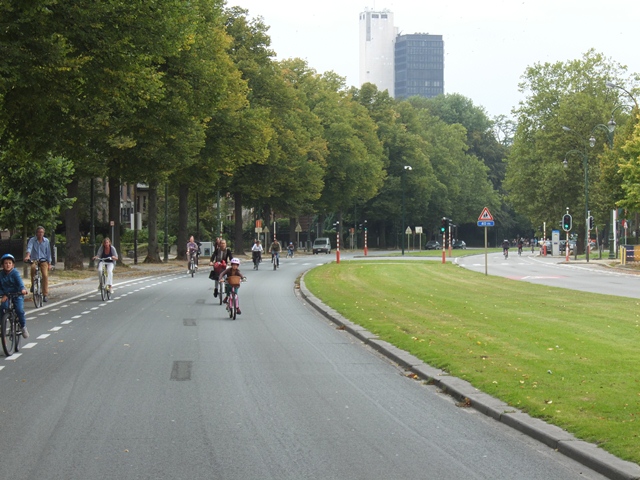 Last Sunday was “No Car Day” in Brussels, so in other words, that day the whole town was a “pedestrian heaven (bicycle heaven?)”. Cars disappeared from the city except for public transport such as taxis and buses. Of course, if you needed to use a car for work or other reasons, it seemed possible to obtain permission in advance, but in practice, cars disappeared impressively from the main roads. Thanks to Car Free Sunday, I used the tram for the first time since my arrival in Brussels and I felt that it was pretty convenient. In particular, on this day the public transport fee was free, so I went around everywhere, even to places where I did not need to go to necessarily. The trams in Brussels have dedicated lines in some sections with platforms at the stops, but most of the lines run on tracks in the middle of ordinary roads. During rush hour, they are surrounded by many cars on all sides. Stopping at a red light is the same for trams as for normal cars. There is no specific ticket selling booth, but there is a small ticket vending machine near the tram stops where you can buy tickets by bankcard only. What surprised me was that although a timetable is posted at the tram stops, the column for Sunday listed only “horaires non-disponibles” and in fact trams ran randomly. Also, when the tram I got on stopped at some traffic light, the driver got off and a little later another driver got on. During this time, the traffic light changed from red to green several times, but for the passengers this was very normal and they did not show any particular reaction. This is unthinkable of in Tokyo. Last Sunday was “No Car Day” in Brussels, so in other words, that day the whole town was a “pedestrian heaven (bicycle heaven?)”. Cars disappeared from the city except for public transport such as taxis and buses. Of course, if you needed to use a car for work or other reasons, it seemed possible to obtain permission in advance, but in practice, cars disappeared impressively from the main roads. Thanks to Car Free Sunday, I used the tram for the first time since my arrival in Brussels and I felt that it was pretty convenient. In particular, on this day the public transport fee was free, so I went around everywhere, even to places where I did not need to go to necessarily. The trams in Brussels have dedicated lines in some sections with platforms at the stops, but most of the lines run on tracks in the middle of ordinary roads. During rush hour, they are surrounded by many cars on all sides. Stopping at a red light is the same for trams as for normal cars. There is no specific ticket selling booth, but there is a small ticket vending machine near the tram stops where you can buy tickets by bankcard only. What surprised me was that although a timetable is posted at the tram stops, the column for Sunday listed only “horaires non-disponibles” and in fact trams ran randomly. Also, when the tram I got on stopped at some traffic light, the driver got off and a little later another driver got on. During this time, the traffic light changed from red to green several times, but for the passengers this was very normal and they did not show any particular reaction. This is unthinkable of in Tokyo.
< Visit of a Japanese Politologue to Belgium >
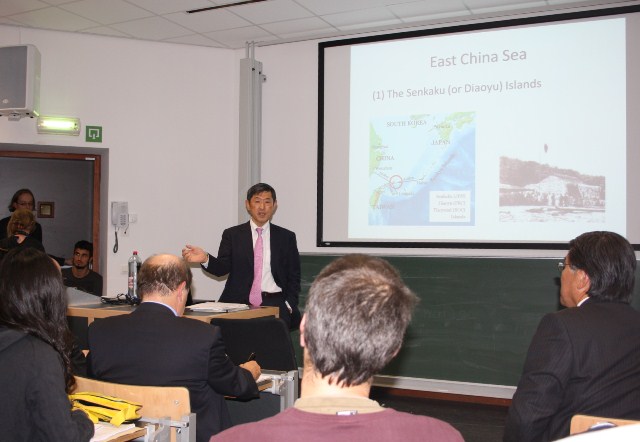 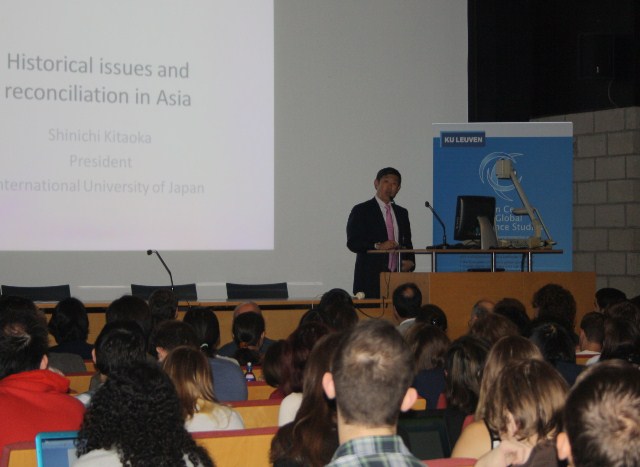 One of Japan’s representative politologues, Mr Shinichi Kitaoka, President of the International University of Japan and Professor at the National Graduate Institute of Policy Studies, visited Belgium last week to lecture at several places such as the Free University of Brussels (ULB) on the theme “The security situation in East Asia and the Japanese defence policy”. Belgians are very interested in the future course of the unstable situation in East Asia and in the new defence policy of the Abe government. The lectures were such a great success that the lecture halls were full with students, some of whom even had to stand and listen. In the lecture at the Catholic University of Leuven (KUL), the professor explained clearly the territorial issues with China and South Korea and the so-called “historic” problems and the problem of “comfort women” from the standpoint of a scholar and historical researcher. His lecture was very well received. In addition, although his stay was short, the professor had the opportunity to exchange views extensively with NATO and EU officials, so he had a very busy schedule. As Professor Kitaoka is currently a key person at the Advisory Panels on defence and security issues under the Abe government, it was a very timely visit. When Mr. Kitaoka worked as Deputy Ambassador at the Permanent Mission of Japan to the United Nations from 2004 to 2006, I worked together with him on the reform of the UN Security Council. It was a nostalgic reunion for me. I, as Ambassador, also have the opportunity to give lectures, but, from my standpoint, there are many things I cannot always talk about. However, I think that it was meaningful that Mr. Kitaoka lectured relatively candidly from his standpoint of a private scholar. One of Japan’s representative politologues, Mr Shinichi Kitaoka, President of the International University of Japan and Professor at the National Graduate Institute of Policy Studies, visited Belgium last week to lecture at several places such as the Free University of Brussels (ULB) on the theme “The security situation in East Asia and the Japanese defence policy”. Belgians are very interested in the future course of the unstable situation in East Asia and in the new defence policy of the Abe government. The lectures were such a great success that the lecture halls were full with students, some of whom even had to stand and listen. In the lecture at the Catholic University of Leuven (KUL), the professor explained clearly the territorial issues with China and South Korea and the so-called “historic” problems and the problem of “comfort women” from the standpoint of a scholar and historical researcher. His lecture was very well received. In addition, although his stay was short, the professor had the opportunity to exchange views extensively with NATO and EU officials, so he had a very busy schedule. As Professor Kitaoka is currently a key person at the Advisory Panels on defence and security issues under the Abe government, it was a very timely visit. When Mr. Kitaoka worked as Deputy Ambassador at the Permanent Mission of Japan to the United Nations from 2004 to 2006, I worked together with him on the reform of the UN Security Council. It was a nostalgic reunion for me. I, as Ambassador, also have the opportunity to give lectures, but, from my standpoint, there are many things I cannot always talk about. However, I think that it was meaningful that Mr. Kitaoka lectured relatively candidly from his standpoint of a private scholar.
< Festival of the Wallonie-Bruxelles Federation and a Ceremony at Mons >
 Last week, a cultural event called the Festival of the Wallonie-Bruxelles Federation was held for 5 days in the French-speaking part of Belgium. September 27th is the day on which in 1830 the Dutch troops were repelled, so this day is the anniversary of the consolidation of the independence of Belgium. Therefore, many events took place in various locations, including a music festival in the heart of Brussels, at the Grand Place. I was invited to one of the official events, a ceremony at Mons (60 km south of Brussels) where I had the opportunity to greet at the reception at the city hall a large number of dignitaries from the Belgian political world, including Prime Minister Mr Di Rupo. The Prime Minister, being also officially the mayor of Mons, held the opening speech as the host of the reception, but having just returned home after attending the UN General Assembly in New York, he seemed a little tired. While we stood talking, he asked me about the economic situation in Japan, such as the result of Abenomics. Also, the speaker of the Senegalese National Assembly was invited as guest of honour, so unexpectedly I was able to talk for a short while about the relationship between Japan and Africa. During my conversation with Mr. Tommy Leclercq, Governor of the Province of Hainaut, he told me that the Japanese sake – my gift to him when we met previously – was delicious. The “Wallonie-Bruxelles Federation” is not an organization based on legislation, but seems to be an organization based on contacts, centered on politicians from the French-speaking region. It is said that 80 % of the residents in Brussels are French-speaking, so the “Wallonie-Bruxelles Federation” connects those residents with Wallonia in the south of Belgium (the French-speaking region). The linguistic situation in Belgium is quite complex. Last week, a cultural event called the Festival of the Wallonie-Bruxelles Federation was held for 5 days in the French-speaking part of Belgium. September 27th is the day on which in 1830 the Dutch troops were repelled, so this day is the anniversary of the consolidation of the independence of Belgium. Therefore, many events took place in various locations, including a music festival in the heart of Brussels, at the Grand Place. I was invited to one of the official events, a ceremony at Mons (60 km south of Brussels) where I had the opportunity to greet at the reception at the city hall a large number of dignitaries from the Belgian political world, including Prime Minister Mr Di Rupo. The Prime Minister, being also officially the mayor of Mons, held the opening speech as the host of the reception, but having just returned home after attending the UN General Assembly in New York, he seemed a little tired. While we stood talking, he asked me about the economic situation in Japan, such as the result of Abenomics. Also, the speaker of the Senegalese National Assembly was invited as guest of honour, so unexpectedly I was able to talk for a short while about the relationship between Japan and Africa. During my conversation with Mr. Tommy Leclercq, Governor of the Province of Hainaut, he told me that the Japanese sake – my gift to him when we met previously – was delicious. The “Wallonie-Bruxelles Federation” is not an organization based on legislation, but seems to be an organization based on contacts, centered on politicians from the French-speaking region. It is said that 80 % of the residents in Brussels are French-speaking, so the “Wallonie-Bruxelles Federation” connects those residents with Wallonia in the south of Belgium (the French-speaking region). The linguistic situation in Belgium is quite complex.
< French RAKUGO Heard in Belgium >
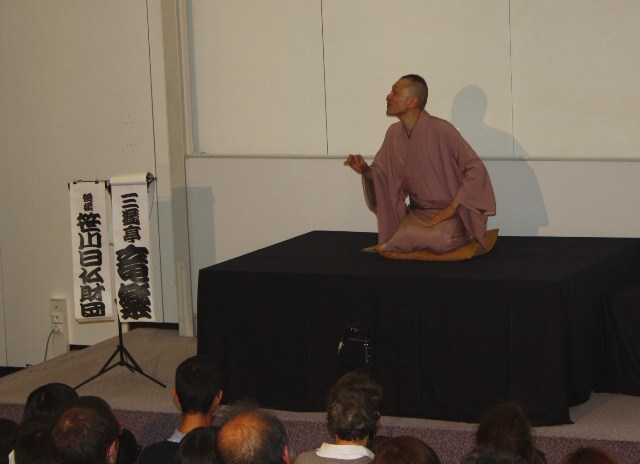 Just one week ago, a RAKUGOKA, a professional comic storyteller, came from Japan to Belgium for a telling-performance of a comic story at a university in Brussels. This storyteller was Master (star performer) Ryuraku Sanyutei, who surprisingly did the telling-performance in French. He performed three short stories with a lot of body language to the great delight of the many guests that had rushed to the venue. What is interesting in RAKUGO is the witty manner of talking, so it cannot be done with translation. There is a way to display a translation on an electronic panel just like simultaneous interpretation, but it is not quite satisfactory. In this respect, if the story is told in the local language, even if not fluent, the humour of the tale is conveyed directly, drawing big laughs. Since about 5 years, the Master has been doing his telling-performance in 6 foreign languages such as German and Italian. He is the only multilingual rakugo (comic story) teller in Japan. Interestingly, although he can do the storytelling in multiple languages, he is not able to have a daily conversation at all. In other words, he not only learned the short comic stories by heart in each language, but in addition, he is so talented that he can perform the stories in such a funny way that the audience does not feel that he memorized them. According to foreigners, the Japanese lack a sense of humour, but the exquisite “laughter” seen in classic RAKUGO truly is an art form. I would like as many foreigners as possible to know about this art. Master Ryuraku, thank you! Just one week ago, a RAKUGOKA, a professional comic storyteller, came from Japan to Belgium for a telling-performance of a comic story at a university in Brussels. This storyteller was Master (star performer) Ryuraku Sanyutei, who surprisingly did the telling-performance in French. He performed three short stories with a lot of body language to the great delight of the many guests that had rushed to the venue. What is interesting in RAKUGO is the witty manner of talking, so it cannot be done with translation. There is a way to display a translation on an electronic panel just like simultaneous interpretation, but it is not quite satisfactory. In this respect, if the story is told in the local language, even if not fluent, the humour of the tale is conveyed directly, drawing big laughs. Since about 5 years, the Master has been doing his telling-performance in 6 foreign languages such as German and Italian. He is the only multilingual rakugo (comic story) teller in Japan. Interestingly, although he can do the storytelling in multiple languages, he is not able to have a daily conversation at all. In other words, he not only learned the short comic stories by heart in each language, but in addition, he is so talented that he can perform the stories in such a funny way that the audience does not feel that he memorized them. According to foreigners, the Japanese lack a sense of humour, but the exquisite “laughter” seen in classic RAKUGO truly is an art form. I would like as many foreigners as possible to know about this art. Master Ryuraku, thank you!
< Belgian Abbeys >
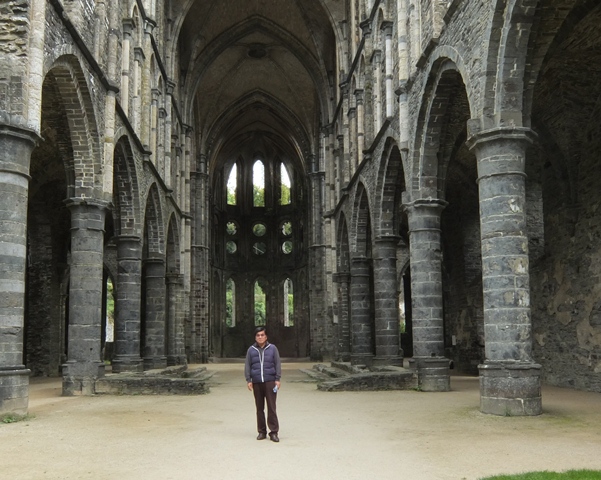 Many castles and church buildings have become sightseeing spots in Belgium, but the country is also dotted with old abbeys and many of them are worth visiting. The convents for women called “Beguinage” are even designated Unesco World Heritage Sites and are a typical example of this. The “Beguinages”, located around the main cities in Flanders (Dutch-speaking area), attract many tourists. I am recently interested in the abbeys of the Citeaux-line, of which some are located in the southern part of Wallonia (French-speaking area). As you may know, the “Cistercian Order” is an abbey that separated and became independent from the “Benedictine Order” in the late 11th century. Their main activities expanded to the north of France, especially in the Burgundy region. The Order is also known as the “Bernardine Order” because it developed greatly under the guidance of Saint Bernard in the 12th century. This religious movement in northern France spread to Belgium where a magnificent abbey was founded in Villers-la-Ville (50 km to the south of Brussels) in the 12th century. It was destroyed during the French Revolution, so unfortunately only ruins are what we see today. The other day, I visited this abbey and I was quite moved by the appearance of these ruins. The particularly strict “Order of Cistercians of the Strict Observance (OCSO), a branch of the “Cistercian Order”, is also known under the name “Trappists Order” and they produced and sold beer at its abbey, so the brand “Trappist Beer” was born. This brand of beer seems to sell pretty well in Japan as well. Many castles and church buildings have become sightseeing spots in Belgium, but the country is also dotted with old abbeys and many of them are worth visiting. The convents for women called “Beguinage” are even designated Unesco World Heritage Sites and are a typical example of this. The “Beguinages”, located around the main cities in Flanders (Dutch-speaking area), attract many tourists. I am recently interested in the abbeys of the Citeaux-line, of which some are located in the southern part of Wallonia (French-speaking area). As you may know, the “Cistercian Order” is an abbey that separated and became independent from the “Benedictine Order” in the late 11th century. Their main activities expanded to the north of France, especially in the Burgundy region. The Order is also known as the “Bernardine Order” because it developed greatly under the guidance of Saint Bernard in the 12th century. This religious movement in northern France spread to Belgium where a magnificent abbey was founded in Villers-la-Ville (50 km to the south of Brussels) in the 12th century. It was destroyed during the French Revolution, so unfortunately only ruins are what we see today. The other day, I visited this abbey and I was quite moved by the appearance of these ruins. The particularly strict “Order of Cistercians of the Strict Observance (OCSO), a branch of the “Cistercian Order”, is also known under the name “Trappists Order” and they produced and sold beer at its abbey, so the brand “Trappist Beer” was born. This brand of beer seems to sell pretty well in Japan as well.
< A Belgian Diplomat Buried in Japan >
During the Meiji era, there was a Belgian diplomat who worked for a long period of 17 years in Japan. His name was Baron Albert d’Annetan. He served as Minister Extraordinary and Plenipotentiary from 1883 to 1910. As it was only from 1921 onwards that Ambassadors were exchanged between Japan and Belgium, Baron d’Annetan was a head of the Belgian mission in Japan. Having served as Dean of the diplomatic missions since 1904, we can imagine that there were frequent contacts with the Government of Japan. At that moment, Japan was going through the Sino-Japanese war and the Russo-Japanese war, so his role as a diplomat must have been important. However, in July 1910 Minister d’Annetan fell ill and passed away in Tokyo. His grave is located at the Zoushigaya cemetery in Tokyo, where I guess he watches over the past and future of Japan.
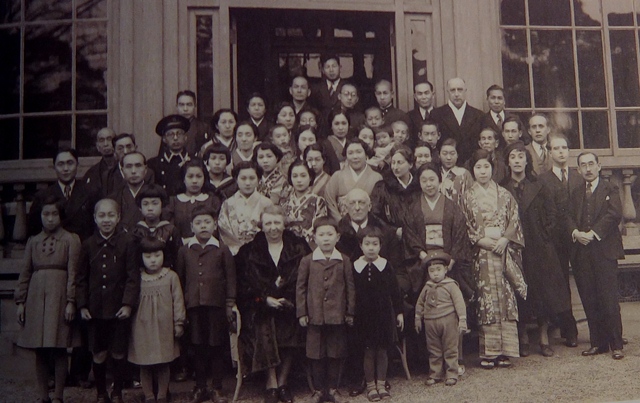 Moreover, there is another Belgian diplomat who worked in Japan for a long time before World War II. His name is Ambassador Albert de Bassonpierre. He worked in Tokyo for about 18 years, from 1920 to 1939, which is even longer than Minister d’Annetan. The Ambassador encountered the Great Kanto Earthquake in 1923 and was involved in relief efforts for the victims. Also, while the militarism in Japan intensified, one serious incident happened after the other, such as the assassination of Prime Minister Takashi Hara (1921), the founding of Manchuria (1932), the May 15 Incident (1932) and the February 26 Incident (1936). He truly was a diplomat who lived during tumultuous times in Japan. It is said that Ambassador Bassonpierre, who loved Japan dearly, left in disappointment in 1939. Currently, his great-grandson works as Minister of the Belgian Embassy in Japan. I feel a historic connection there. Moreover, there is another Belgian diplomat who worked in Japan for a long time before World War II. His name is Ambassador Albert de Bassonpierre. He worked in Tokyo for about 18 years, from 1920 to 1939, which is even longer than Minister d’Annetan. The Ambassador encountered the Great Kanto Earthquake in 1923 and was involved in relief efforts for the victims. Also, while the militarism in Japan intensified, one serious incident happened after the other, such as the assassination of Prime Minister Takashi Hara (1921), the founding of Manchuria (1932), the May 15 Incident (1932) and the February 26 Incident (1936). He truly was a diplomat who lived during tumultuous times in Japan. It is said that Ambassador Bassonpierre, who loved Japan dearly, left in disappointment in 1939. Currently, his great-grandson works as Minister of the Belgian Embassy in Japan. I feel a historic connection there.
|

